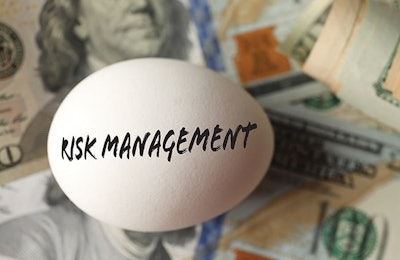
Volatility and risk in the poultry and egg sectors have resulted in insurers limiting the amount of coverage they're willing to offer, and insurers have been more hesitant to write coverage in this sector. The frequency and severity of losses in the poultry industry paired with limited carrier options have resulted in increased rates for everyone, regardless of whether they've had losses.
"We've hit a perfect storm of variables," said Brett Cohrs, senior vice president with Palomar Insurance. "Catastrophic and other losses such as wildfires across the country and globe have been hitting the overall property market hard since 2017. At around the same time, the poultry industry – egg and poultry processing – had a series of extremely large fire losses."
According to Ryan Butler, vice president of food and ag risk management with Cottingham & Butler Insurance Services (C&B), "The days of just placing insurance are over."
"Over the last 15 years, the operations have grown in size and sophistication, so it is imperative that policyholders have specialized insurance brokers on their team who can not only structure stable property and casualty insurance programs, but who also have expertise and bandwidth to identify and manage the unique loss exposures currently plaguing the sector," he said. "Having a broker who can complete a comprehensive exposure analysis, act as an outsourced risk manager, and pinpoint the optimal risk transfer strategy with an aim of buying less insurance over the long run is the first step to mitigating insurance cost and lowering the total cost of risk long term.”
Larger barns equal higher values and more birds, which equates to higher risk, and the migration to cage-free design will only exacerbate the size and complexities of risks and losses in the future. The building value, the loss of birds, and the loss of business income and the cost for the egg producer to purchase eggs to make up for their lost production are all things to consider in evaluating the risk of an operation, Cohrs said.
Analyzing and managing loss exposures
Insurers have not started demanding that producers work with specific contractors or follow certain operational guidelines, but those are conversations that brokers should have with producers to get ahead of the industry.
"We have evaluated the industry’s losses and have pinpointed the root causes of fire claims over the past eight years, and there are surprisingly only four or five common causes of loss that continue recurring," said Nicole Gentz, food and ag safety specialist with C&B. "While it is impossible to engineer 100% of the risk out of anything, we believe that many of the recent fire losses could have been mitigated if the right protocol and stewardship program was in place."

When producers minimize their risk for any potential loss, they have a better chance of remaining profitable. (almagami | Bigstock.com)
By sharing and discussing industry best practices regarding techniques to manage potential risks, producers can start formulating stronger protocols and practices that will alleviate growing exposures, and thus hopefully can better control the total cost of risk and rely less on the standard insurance market for attritional loss exposures in the long run.
Butler said that even some new barns are being built incorrectly because the contractors sometimes don’t fully understand best practices from a fire mitigation perspective. He added that producers should not rely solely on the general contractors when designing new barns, and should include a specialist risk manager from the start to ensure that barn and electrical systems are designed to effectively mitigate fire exposures.
While infrared testing can be a tool utilized to help tell the story of how effective a producer’s preventative maintenance and facility’s program really is, it’s solely a snapshot in time and not indicative of what the future holds. Follow-up strategy and management is an essential step, Gentz added.
"Most insurers have standards including firewall requirements, thermographic imaging of electrical components, age restrictions and spatial separation between barns," Cohrs said. "If an insured does not meet all these requirements, a carrier might refuse to offer coverage or increase rates and limit coverage terms and conditions."
With the sophistication of modern layer operations comes a need for managing the general risks and concerns that can be associated with these bigger operations.
"Commercial agriculture is a specialized industry where boots-on-the-ground risk management is imperative," Gentz said. "It’s an industry where you’ve got to know the game in order to be an effective risk consultant because nowadays the theme of 'this is how we’ve always done it' won’t work. The facilities are too complex and sophisticated to be operating at the same capacity as we were in the 90s."
She said layer operations need to look at risk management from a holistic and proactive perspective, rather than just a farming exposure, so that operators become fully aware of the highest exposures and can determine how to best correct and manage them.
C&B completes numerous reviews and risk assessments for the layer industry because it is imperative that operators lower the severity and frequency of losses. By building updated industry best practice guidelines and a proactive risk management platform that pairs with insurance products, the company has been able to help its clients reduce loss exposures and better control insurance costs.
Are cage-free systems to blame for the increase in insurance claims?
It is no secret that producers have been building more cage-free systems in recent years, but does that have anything to do with the increase in claims?
"This is an observation that we have made and are constantly addressing but, while it is a very different environment, it is not the root cause of increased claims and the hardening market," said Ross Milne, food and ag risk management consultant with C&B. "The caged facilities have a very different exposure profile than cage-free facilities due to dustier environment with more bird movement, and a lot of egg producers are managing preventative maintenance in these new barns in a similar manner as they have in the past. However, the way you approach and mitigate these new risks has to evolve."

While cage-free buildings may not be the reason for an increase in insurance claims, they can result in a more expensive claim due to scale and sophistication of the building. (Ginasanders | Dreamstime.com)
This has forced Milne and his colleagues to change the way they approach and advise clients about risk management principles, how to oversee and manage third-party contractors (one of the leading causes of loss), develop better housekeeping protocols, and provide guidance on up-to-date electrical and barn design best practices.
Final thoughts
Acquisitions of other companies can make managing risk harder and even more important, Milne said.
"The additional cost to build and maintain (cage-free) structures will result in higher claims if an event does occur simply due to scale," Cohrs said.
Regardless of production type, without proper mitigation of their risks, the number of insurance claims will not go down and, within 5 years, it could be hard for some operations to even get insurance. The cost will get so high that some operations will not be able to afford it.
“Producers should be working with their insurance brokers to help them manage loss exposures to minimize claims and thus eventually relying less on the standard market to place insurance,” Butler said.
Risk transfer and insurance renewal best practices for egg producers
- Time is money. Push brokers hard to receive renewal quotes three to four weeks prior to policy expiration dates. Waiting until the last week to finalize the program gives underwriters negotiation leverage and increases the chance there will be inconsistencies across carriers.
- Ensure continuity. Shared and layered property programs are becoming standard practice. Make sure there is concurrent (consistent) coverage, terms and expiration dates among all carriers on the proper placement. This will help ensure there are no coverage gaps and will increase the likelihood you will receive full reimbursement in the event of a claim.
- Improve risk management stewardship. Enhance your safety and risk management programs now and find the right partners to assist. Underwriters will demand producers improve practices and develop more robust submission materials in the future, so get ahead of the curve.
- Retention is the future. Deductibles will continue to increase, so find the right advisers who can develop mechanisms that help operations avoid taking this increased exposure onto their balance sheets.
- Data integrity is key. Update your statement of values and engineering reports and ensure your broker knows how to best articulate your story. Getting your submission to the ‘top of the underwriting pile’ is very important in today's market.
- Price is not the only consideration. Reducing premium cost is easy and can be done by buying a policy with limited coverage. Don’t fall into the “price” trap; work with your broker to ensure your policy fully covers the actual exposures you don’t want on your balance sheet.
If loss exposures are not correctly managed, standard insurance may become cost prohibitive. Butler said it’s time to be proactive and forward-thinking with regard to reducing risks and structuring insurance programs.
Source: Cottingham & Butler Insurance Services

















